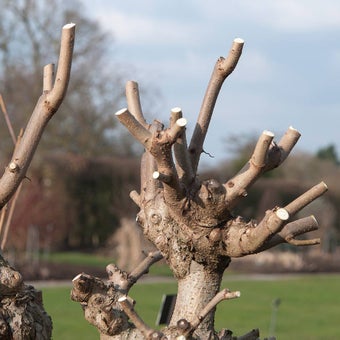
Quick facts
Suitable for - Eucalyptus sp.
Timing - Late winter to early spring (February to March)
Difficulty - Easy
Suitable for...
Young eucalyptus specimens need some formative pruning to grow into well-shaped mature trees. Some species can also be trained into multi-stemmed bushes, either by coppicing an established tree, or by training two-year-old trees as multi-stemmed shrubs from the beginning of their life.
If you have a small garden, consider coppicing or pollarding established trees. Both these methods will keep their size under control.
Coppicing creates a multi-stemmed bush, by chopping back the stems to the ground every year or every few years. It is particularly good for Eucalyptus gunnii, E. globulus, E. dalrympleana and E. pauciflora as it not only encourages new stems each year, but also juvenile leaves, which some people say are more attractive than the mature eucalyptus leaves.
Pollarding restricts the growth once it reaches a certain height through pruning. Pollarding is more difficult and you usually would require the services of an professional aborist, especially if working at heights. Pollarding is suitable for E. dalrympleana and E. pauciflora.
When to prune eucalyptus
Formative pruning, coppicing and pollarding of eucalyptus are best carried out in late winter to early spring (February to March), just before plants are actively in growth.
How to prune eucalyptus
Formative pruning as a standard tree
Standard trees have a clear trunk and a head, or canopy, of branches. Young eucalyptus can be grown as standards with a 1-2m (3¼ -6½ ft) trunk.
Eucalyptus grow with a clear central leading branch that grows upwards ahead of the other branches. It is important not to cut this central leader, as this could spoil the final shape of the tree.
Suitable for: E. coccifera, E. dalrympleana, E. gunnii, E. parvifolia, E. pauciflora, E. pulvurulenta and E. urnigera.
Year one
- Remove all side branches from the lower third of the main stem
- Shorten by half all the sideshoots on the middle third of the main stem
- Leave the sideshoots on the top third of the main stem unpruned, apart from the removal of dead, diseased or damaged growth
- Cut to outward facing , so that the resulting growth extends outwards rather than into the centre of the tree
Year two
- Remove completely the side shoots that were shortened by half in year one (which should be now be in the lower third of the tree)
- Shorten by half the sideshoots on the middle third of the tree
- Remove any crossing or misplaced branches in the upper third of the tree
Year three
- Follow the same steps as for year two
Years four and five
- Clear the trunk of side branches to the height desired
- Continue to remove any crossing, dead, diseased or misplaced branches from the canopy
Formative pruning as a multi-stemmed bush
This method is particularly suitable for two-year-old trees of Eucalyptus gunnii, E. globulus, E. dalrympleana and E. pauciflora, as it shows off their attractive, rounded juvenile foliage.
Year one
- Cut the main stem of a two-year-old tree straight across at the desired height, cutting as low as 8cm (3in) from ground level if required. Trim the wound so that there are no rough edges
Year two
- Multiple branches should have regenerated from the wound and from below ground level. Select three or four of these (choosing strong, well-spaced branches), and remove all other branches completely, cutting them back to the base
Year three and onwards
- Allow sideshoots to develop from the chosen branches, removing only those sideshoots that are too low and dragging on the ground, or are crossing, rubbing or otherwise badly placed
- Remove any excess new stems arising from the base
- Occasional of congested side branches may be necessary as the bush matures
- Established trees require little pruning other than the removal of any dead material
Coppicing and pollarding eucalyptus
Coppicing and pollarding are best initiated early in the life of the tree, rather than used on over large or damaged mature trees, which may or may not regenerate in response.
- To coppice a eucalyptus, cut back the trunk or branches to 5-7.5cm (2-3in) above the ground or to the stubs left the previous year
- When pollarding a eucalyptus, cut back to stubs on the main trunk, usually 2m (6½ft) high
Problems
Eucalyptus is usually trouble-free, but may occasionally suffer from oedema, and from the very similar-looking eucalyptus gall wasp. In cooler or exposed areas, they may suffer from frost, wind and other winter damage.
Young shoots on recently coppiced trees can be vulnerable to snapping off in strong winds. Further shortening in subsequent seasons to encourage stockier growth may reduce the risk.







